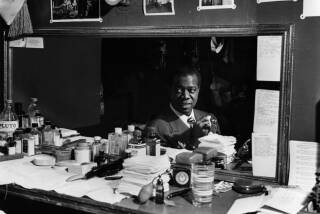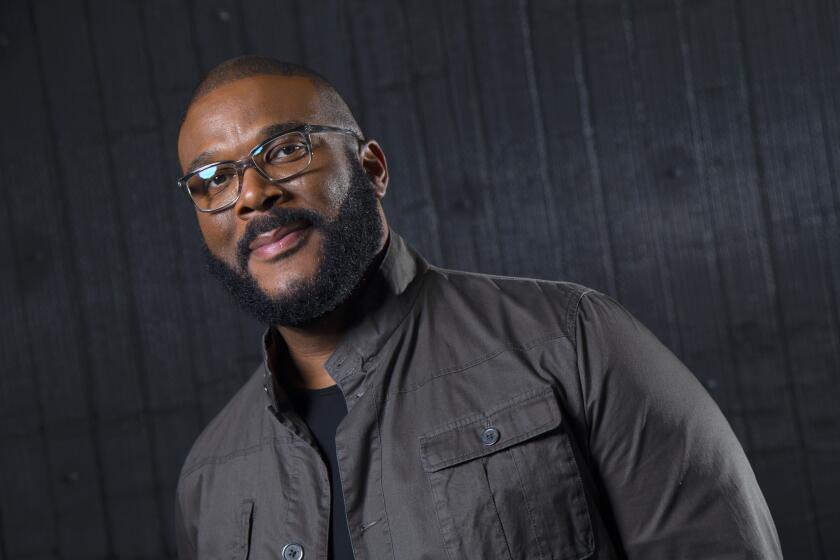Katz and Collette: a Blast From Past : Jazz: The two, who were part of Chico Hamilton’s legendary quintet of the mid-’50s, will reunite tonight in Newport Beach.
- Share via
FULLERTON — As a member of drummer Chico Hamilton’s groundbreaking chamber-jazz quintet of the mid-1950s, Fred Katz set the music world on its ear by bringing his cello into the front line of Hamilton’s ensemble.
Strangely enough, the two men might never have gotten together if it hadn’t been for Lena Horne.
“I got started in the jazz world with Chico because of an eight-bar cello solo in an arrangement of ‘Frankie and Johnnie’ that Lena Horne sang,” Katz recalled recently in his home here.
“I’d been hired to play behind her in the orchestra, and the arrangement of ‘Frankie and Johnnie’ she did had a solo spot for the cello. At the end of two or three weeks, Lena came by and said, ‘I love the way you play that solo,’ ” he said.
“Later, I played a little jazz piano for her at one of the cast parties, and a few weeks after I get a call: ‘Would you care to be Lena Horne’s musical director?’ And Chico Hamilton was the drummer in her trio.”
When Hamilton started in his own group in 1955, he called on Katz. “Originally he wanted to do it with a French horn player,” Katz explained. “And I said, ‘What about the possibility of playing with a cello?’ ”
The result was one of the most famous quintets in jazz.
Katz, Hamilton, saxophonist Buddy Collette, guitarist Jim Hall and bassist Carson Smith developed a clean, sophisticated sound replete with classical touches that caught on with audiences around the world.
Katz will be reunited with his longtime friend and colleague Collette tonight at the Hyatt Newporter in Newport Beach when he appears with the saxophonist’s quartet.
(Also joining Collette’s ensemble tonight is trombonist Britt Woodman. Woodman, who’s probably best known for replacing Lawrence Brown in Duke Ellington’s Orchestra during the early ‘50s, grew up with Collette and another native Californian, Charles Mingus. Now living in New York and a member of Wynton Marsalis’ Lincoln Center Jazz Orchestra, Woodman also worked with Lionel Hampton, and recorded a number of dates with bassist Mingus. Rounding out the group appearing at the Hyatt Newporter is guitarist Al Viola, bassist Richard Simon and drummer Harvey Mason.)
Katz’s cello wasn’t immediately part of Hamilton’s band.
“We opened up in a real dive in Long Beach called Strollers,” he said, “with hookers coming in and all that. I played piano on a lot of the jazz tunes, playing the cello on ballads.”
“In between sets,” added Collette, in a recent phone conversation from his Los Angeles home, “Fred would get up and play a classical sonata or something by himself, for contrast.
“And a lot of times he’d play too long and we’d have to get up on the bandstand, which was very small, and by the time he’d open his eyes and look up, there we’d be. Chico would start playing and Fred was trapped up there in front of the band; he couldn’t get back to the piano. So he’d start playing his piano parts on cello. And that’s the first time we knew it would work,” Collette said.
Katz remembers it well. “I’d just get up there and fool around between sets. And then the guys would join in, and that started the free-form improvisation which we became quite famous for. I finally gave up the piano all together.”
“The magic of the thing,” said Collette, “was the contrast in personalties between Fred and Jim Hall. Fred is very aggressive and Jim is way laid back. Jim would just kind of wait for his spot, he didn’t want to clash, while Fred would be playing chords on everything. Then Jim would play these beautiful solos with Fred comping.”
What was supposed to be a two-week engagement at Strollers turned into six months. Legendary disc jockey Sleepy Stein, from L.A. jazz station KFOX, caught wind of the group and was soon broadcasting live from the club.
Their reputation was set after a triumphant appearance at the Newport Jazz Festival, and the group appeared in the 1958 film “Jazz On A Summer’s Day.” In 1989, the group reformed for a recording and a reunion tour of Europe.
But Katz’s time with Hamilton is but one part of his many-faceted career. A stroll through his converted-garage studio gives glimpses into his history and interests.
The walls are decorated with photos of the cellist in action, as well as album covers that document his career as composer. A chess board sits at the ready, and here and there are examples of primitive art gathered during his days as an anthropology instructor.
A copy of the sheet music to “Satan (Wears A Satin Gown)” written by Katz and Jack Wilson, is signed by Frankie Laine. On another wall is a map of the universe where constellations circle the North Star. Piles of staff paper await the composer.
In fact, composing, mostly in the classical style, is now the centerpiece of Katz’s activity.
His “Concerto for Cello and Jazz Wind Orchestra,” performed by George Neikrug, has recently been released by Evergreen Music. He’s currently working on a jazz opera (“It may turn out to be two or three pieces,” he added), another large piece inspired by Jewish mysticism and a commission based on the writings of Chief Seattle.
“What I’m going for now is music that has some kind of substance, that relates to an environmental or philosophical idea,” he said. “But sometimes I’ll just sit down at the piano and a nice melody will hit the fingers.”
Later, Katz plays from one of Bach’s suites for solo cello as a photographer snaps his picture. Surely, this is what is meant by a “Renaissance man.”
Katz, born in Brooklyn in 1919, began playing cello at age 12. At 15, he played the Saint-Saens cello concerto at New York’s Town Hall. An accomplished pianist, he spent time accompanying such singers as Horne, Laine, Tony Bennett and Vic Damone.
After leaving Hamilton’s band, Katz began writing film scores for art and offbeat films, including Roger Corman’s “The Wasp Woman” and Corman’s 1960 film “Little Shop Of Horrors” (which included a young Jack Nicholson). Though he was doing well in Hollywood, it wasn’t enough.
“I always felt this need to be involved with people, involved with the so-called high arts,” the self-declared “old-style” radical said. “So I began taking the cello down to Venice where the poets used to gather and play behind them. That was part of the culture in the late-’50s, early-’60s: poetry and jazz music.”
At a reading in the home of beat-chronicler Lawrence Lipton (author of “The Holy Barbarians”), Katz met anthropologist Ted Carpenter, who was forming the anthropology department for Valley College (now Cal State Northridge). He asked the cellist to join him. His idea was to pair an academician with an artist.
“Suddenly, I was plunged into the academic world,” he said.
Katz, who had no degree, first taught about jazz and primitive music, which had been a special interest of his. “Then I began to teach aesthetics, and finally anthropology. I had to study very, very hard.” Katz retired from teaching nine years ago, at which time he was a professor in anthropology at Cal State Fullerton.
But Katz, whose interests also include Jewish mysticism, medieval literature and magic tricks, is not one to keep the various facets of his life separate.
His anthropology studies have led to music, as witnessed by his tune, “The Walker,” inspired by the mythology of the Brazilian rain-forest peoples. Collette’s ensemble will perform the piece tonight.
“They have a belief that a mysterious figure came out of the forest and walked the land. And everywhere he walked, he left culture and societal relationships. He might be considered the messiah of the Brazilian jungle, the redeemer,” he said.
“I loved the idea of this mysterious figure walking the jungle and had to write something about it,” he said. “And, of course, walking in jazz--when the bass player works single notes--made it all come together perfectly.”
*The Buddy Colette Quartet, with Fred Katz and Britt Woodman, appears tonight, at the Hyatt Newporter, 1107 Jamboree Road, Newport Beach. (714) 729-1234.
More to Read
The biggest entertainment stories
Get our big stories about Hollywood, film, television, music, arts, culture and more right in your inbox as soon as they publish.
You may occasionally receive promotional content from the Los Angeles Times.










